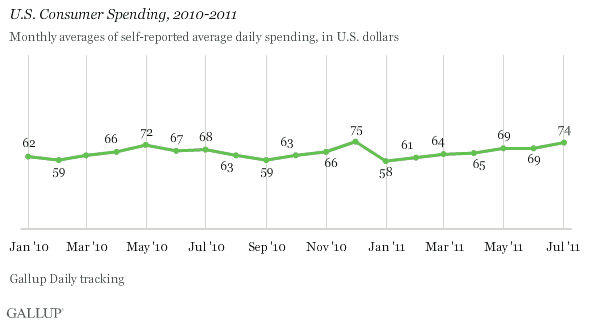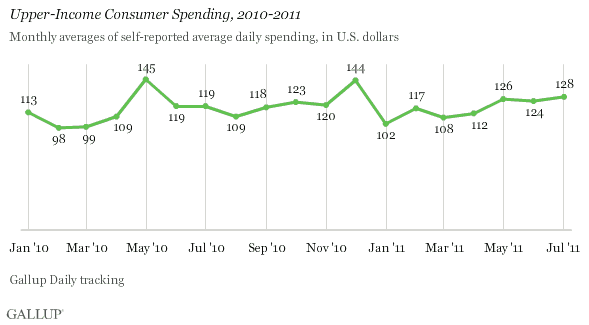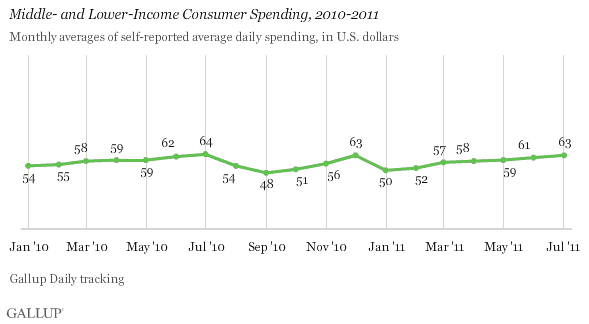PRINCETON, NJ -- Overall self-reported daily U.S. consumer spending in stores, restaurants, gas stations, and online averaged $74 per day in July -- up from $69 in June and $68 in July 2010.

Americans spent more per day, on average, in July than they have in any month since December of last year.
Upper-Income Spending Up From a Year Ago
Upper-income spending (among Americans making $90,000 or more annually) averaged $128 per day in July -- essentially the same as the $124 and $126 in June and May, respectively. But this is higher than the $119 average of June and July 2010.

Lower- and Middle-Income Americans Continue to Hold Back
Americans who make less than $90,000 per year reported spending an average of $63 per day during July -- on par with the $61 of June and the $64 of July 2010.

Implications
The July increase in spending suggests some consumers may be doing early back-to-school shopping, as those aged 30 to 49 saw a sharp increase in spending compared with June. Upper-income consumers also appear to be leading this -- their spending levels are slightly higher than they were a year ago. Middle- and lower-income consumers, however, are spending about the same as in 2010.
Another potential reason for the increase could involve an uptick in vacation travel. This could be partly related to efforts to escape the recent heat wave as both the East and the South showed month-over-month spending increases. Those 65 and older also increased their spending in July compared with June.
Regardless, while the July spending uptick may be a good sign for more back-to-school spending and potential summer travel ahead, consumer spending data from the summer of 2010 suggest the opposite. Spending declined from July to August last year. This may be the case once again in 2011 as the U.S. economy shows signs of slowing. Add in rapidly plunging consumer confidence along with high unemployment, and a repeat of last year's decline in spending seems likely.
Gallup.com reports results from these indexes in daily, weekly, and monthly averages and in Gallup.com stories. Complete trend data are always available to view and export in the following charts:
Daily: Employment, Economic Confidence and Job Creation, Consumer Spending
Weekly: Employment, Economic Confidence, Job Creation, Consumer Spending
Read more about Gallup's economic measures.
View our economic release schedule.
Survey Methods
For Gallup Daily tracking, Gallup interviews approximately 1,000 national adults, aged 18 and older, each day. The consumer spending results are based on a random sample of approximately 500 adults each day.
National results for June are based on Gallup Daily tracking interviews with 15,108 national adults conducted July 1-31, 2011. For this sample, one can say with 95% confidence that the maximum margin of sampling error is ±1 percentage point.
Interviews are conducted with respondents on landline telephones and cellular phones, with interviews conducted in Spanish for respondents who are primarily Spanish-speaking. Each sample includes a minimum quota of 400 cell phone respondents and 600 landline respondents per 1,000 national adults, with additional minimum quotas among landline respondents for gender within region. Landline telephone numbers are chosen at random among listed telephone numbers. Cell phone numbers are selected using random-digit-dial methods. Landline respondents are chosen at random within each household on the basis of which member had the most recent birthday.
Samples are weighted by gender, age, race, Hispanic ethnicity, education, region, adults in the household, and phone status (cell phone only/landline only/both, cell phone mostly, and having an unlisted landline number). Demographic weighting targets are based on the March 2010 Current Population Survey figures for the aged 18 and older non-institutionalized population living in U.S. telephone households. All reported margins of sampling error include the computed design effects for weighting and sample design.
In addition to sampling error, question wording and practical difficulties in conducting surveys can introduce error or bias into the findings of public opinion polls.
For more details on Gallup's polling methodology, visit www.gallup.com.
